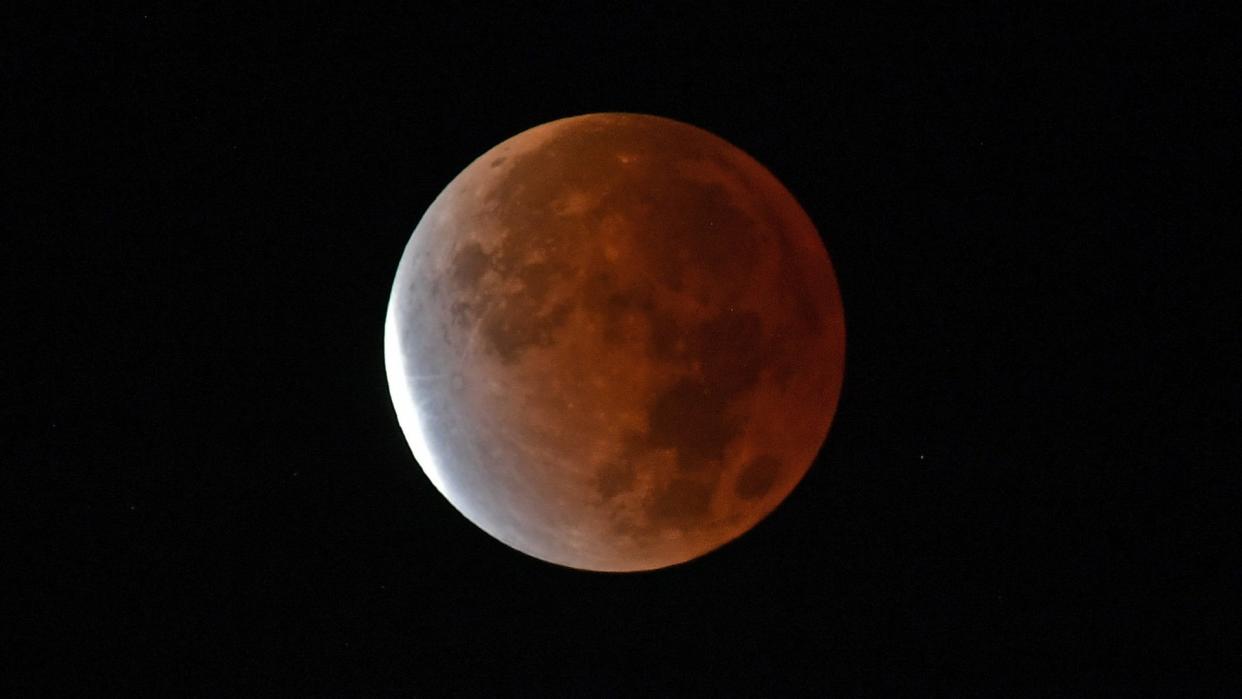The Full Hunter's Moon experiences a partial lunar eclipse on Oct. 28. Here's what to expect

Eclipses of the sun and moon usually come in pairs. A solar eclipse is almost always accompanied by a lunar eclipse two weeks before or after it, since in two weeks the moon travels halfway around its orbit and is likely to form another almost-straight line with Earth and the sun.
This month will be no exception. Two weeks after casting its shadow across the Americas on Oct. 14 during an annular solar eclipse, the moon will swing around to barely skim through the northern edge of the Earth's own shadow on Saturday, Oct. 28.
This will be almost like the lunar eclipse in May, though the moon passes not quite so wide of the center of the Earth's shadow and manages to give the Earth's dark umbra a glancing blow; an underwhelming postscript to the annular eclipse of the sun that was staged for North Americans exactly two weeks earlier.
Ironically, most of those who enjoyed the sight of the "ring of fire" solar eclipse earlier this month will not be able to see the partial lunar eclipse since it will occur when the moon is below the horizon, during the daytime. This time, it is the Earth's Eastern Hemisphere that will be facing the moon when this eclipse takes place.
Related: Watch the partial lunar eclipse of the Full Hunter's Moon on Oct. 28 with these free livestreams
Canada and New England's brief glimpse
TOP TELESCOPE PICK:

See the moon up close! We recommend the Celestron Astro Fi 102 as the top pick in our best beginner's telescope guide.
However, the Earth's rotation will bring the Canadian Maritime provinces into position to see the last of the umbra (the darker, inner part of the Earth's shadow) slip off the moon as it rises and sharp-eyed New Englanders might be able to perceive the faint shading of the penumbra (the lighter, outer part of Earth's shadow) as the moon appears above their horizon.
It is debatable, however, whether the last of the umbra or the last vestige of the penumbra will be readily visible from these regions.

Remember that an eclipsed moon rises right around the time when the sun is setting. As such, the bright, almost-daylight twilight sky at that time may cut as much as 15 minutes from your eclipse viewing. The eastern sky needs to be a bit darker and the moon needs to be a bit higher; at least clear of any horizon haze so that you can have a clear shot at it. From Newfoundland and Labrador, mid-eclipse comes at or shortly after moonrise.
The rest of North America will see nothing, as this shady little drama will have ended before moonrise.
The accompanying timetable tells you what to look for and when. Dashes indicate that the moon is below the local horizon and hence is not visible. NDT denotes Newfoundland Daylight Time.
The first event listed is the moon entering the penumbra, the faint outer extremity of the Earth's shadow. But this shadow is so light that the moon doesn't begin to change appearance until the moon's diameter has penetrated it by at least 70 percent. The first hint of the upcoming event may be visible as much as 1 hour and 8 minutes before mid-eclipse. Around that time a very weak shading across the moon's left side; this is the pale outer fringe of the Earth's penumbra. The penumbral shading will get stronger for the next 28 minutes.
At that point, 40 minutes before mid-eclipse, the moon's edge will begin to intrude into the dark umbra for the start of partial eclipse. The umbra is much darker than the penumbra and fairly sharp-edged. Partial eclipse lasts only 77 minutes.
At mid-eclipse the umbra covers at most only about 1/20 of the area of the moon's circle; or put another way, it gets only as far as 12.2 percent across the moon's diameter. At greatest eclipse the umbra's edge falls just shy of touching the brilliant rayed crater, Tycho.
After the maximum eclipse, the moon will soon exit the umbra; just 37 minutes later partial eclipse ends, and the show is pretty much over.
Coming attractions
The next lunar eclipse will be strictly a penumbral event and will occur on March 25th of next year and will favor much of North and South America. The next total lunar eclipse will not come until March 14, 2025.
If you want to get an up-close look at the moon during the partial eclipse, the full moon or any other time, our guides to the best telescopes and best binoculars are a great place to start.
And if you're looking to take photos of lunar eclipses, full moons or the night sky in general, check out our guide on how to photograph the moon or how to photograph a lunar eclipse, as well as our best cameras for astrophotography and best lenses for astrophotography.
Editor's Note: If you snap an image of the partial lunar eclipse and would like to share it with Space.com’s readers, send your photo(s), comments, and your name and location to spacephotos@space.com.
Joe Rao serves as an instructor and guest lecturer at New York's Hayden Planetarium. He writes about astronomy for Natural History magazine, the Farmers' Almanac and other publications.

